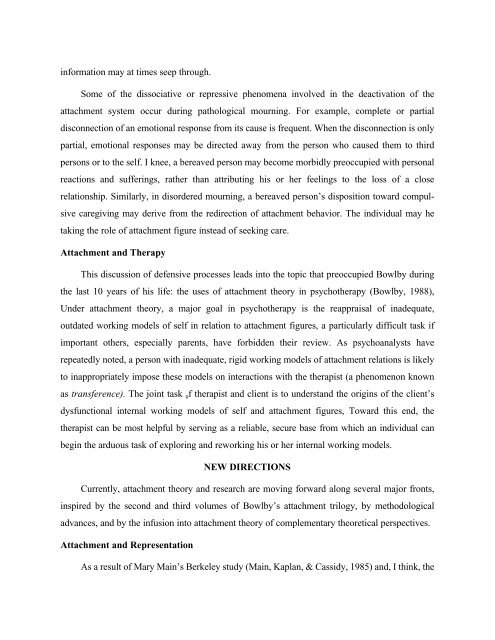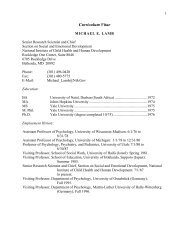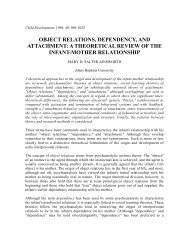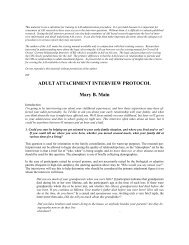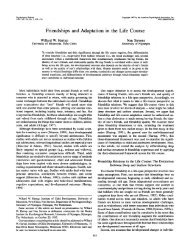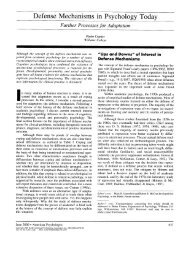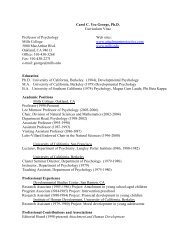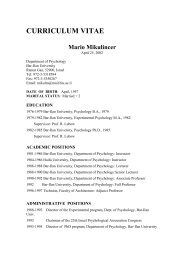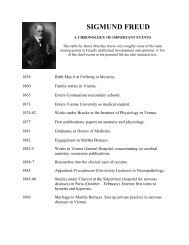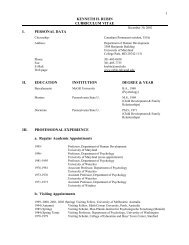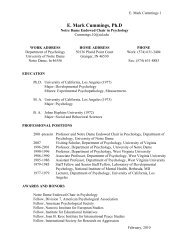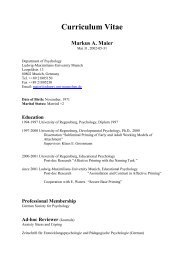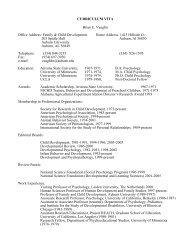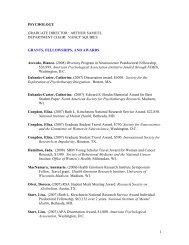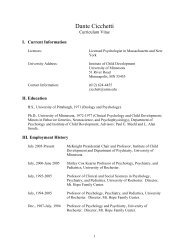the origins of attachment theory: john bowlby and mary ainsworth ...
the origins of attachment theory: john bowlby and mary ainsworth ...
the origins of attachment theory: john bowlby and mary ainsworth ...
Create successful ePaper yourself
Turn your PDF publications into a flip-book with our unique Google optimized e-Paper software.
information may at times seep through.<br />
Some <strong>of</strong> <strong>the</strong> dissociative or repressive phenomena involved in <strong>the</strong> deactivation <strong>of</strong> <strong>the</strong><br />
<strong>attachment</strong> system occur during pathological mourning. For example, complete or partial<br />
disconnection <strong>of</strong> an emotional response from its cause is frequent. When <strong>the</strong> disconnection is only<br />
partial, emotional responses may be directed away from <strong>the</strong> person who caused <strong>the</strong>m to third<br />
persons or to <strong>the</strong> self. I knee, a bereaved person may become morbidly preoccupied with personal<br />
reactions <strong>and</strong> sufferings, ra<strong>the</strong>r than attributing his or her feelings to <strong>the</strong> loss <strong>of</strong> a close<br />
relationship. Similarly, in disordered mourning, a bereaved person’s disposition toward compul-<br />
sive caregiving may derive from <strong>the</strong> redirection <strong>of</strong> <strong>attachment</strong> behavior. The individual may he<br />
taking <strong>the</strong> role <strong>of</strong> <strong>attachment</strong> figure instead <strong>of</strong> seeking care.<br />
Attachment <strong>and</strong> Therapy<br />
This discussion <strong>of</strong> defensive processes leads into <strong>the</strong> topic that preoccupied Bowlby during<br />
<strong>the</strong> last 10 years <strong>of</strong> his life: <strong>the</strong> uses <strong>of</strong> <strong>attachment</strong> <strong>the</strong>ory in psycho<strong>the</strong>rapy (Bowlby, 1988),<br />
Under <strong>attachment</strong> <strong>the</strong>ory, a major goal in psycho<strong>the</strong>rapy is <strong>the</strong> reappraisal <strong>of</strong> inadequate,<br />
outdated working models <strong>of</strong> self in relation to <strong>attachment</strong> figures, a particularly difficult task if<br />
important o<strong>the</strong>rs, especially parents, have forbidden <strong>the</strong>ir review. As psychoanalysts have<br />
repeatedly noted, a person with inadequate, rigid working models <strong>of</strong> <strong>attachment</strong> relations is likely<br />
to inappropriately impose <strong>the</strong>se models on interactions with <strong>the</strong> <strong>the</strong>rapist (a phenomenon known<br />
as transference). The joint task 0f <strong>the</strong>rapist <strong>and</strong> client is to underst<strong>and</strong> <strong>the</strong> <strong>origins</strong> <strong>of</strong> <strong>the</strong> client’s<br />
dysfunctional internal working models <strong>of</strong> self <strong>and</strong> <strong>attachment</strong> figures, Toward this end, <strong>the</strong><br />
<strong>the</strong>rapist can be most helpful by serving as a reliable, secure base from which an individual can<br />
begin <strong>the</strong> arduous task <strong>of</strong> exploring <strong>and</strong> reworking his or her internal working models.<br />
NEW DIRECTIONS<br />
Currently, <strong>attachment</strong> <strong>the</strong>ory <strong>and</strong> research are moving forward along several major fronts,<br />
inspired by <strong>the</strong> second <strong>and</strong> third volumes <strong>of</strong> Bowlby’s <strong>attachment</strong> trilogy, by methodological<br />
advances, <strong>and</strong> by <strong>the</strong> infusion into <strong>attachment</strong> <strong>the</strong>ory <strong>of</strong> complementary <strong>the</strong>oretical perspectives.<br />
Attachment <strong>and</strong> Representation<br />
As a result <strong>of</strong> Mary Main’s Berkeley study (Main, Kaplan, & Cassidy, 1985) <strong>and</strong>, I think, <strong>the</strong>


